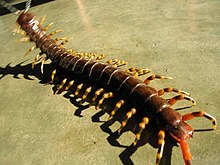| Scolopendra gigantea Temporal range: Pleistocene–recent | |
|---|---|

| |
| Scientific classification | |
| Domain: | Eukaryota |
| Kingdom: | Animalia |
| Phylum: | Arthropoda |
| Subphylum: | Myriapoda |
| Class: | Chilopoda |
| Order: | Scolopendromorpha |
| Family: | Scolopendridae |
| Genus: | Scolopendra |
| Species: | S. gigantea |
| Binomial name | |
| Scolopendra gigantea Linnaeus, 1758 | |

Scolopendra gigantea, also known as the Peruvian giant yellow-leg centipede or Amazonian giant centipede, is a centipede in the genus Scolopendra. It is the largest centipede species in the world, with a length exceeding 30 centimetres (12 in). Specimens may have 21 or 23 segments. It is found in various places throughout South America and the extreme south Caribbean, where it preys on a wide variety of animals, including other sizable arthropods, amphibians, mammals and reptiles.
Distribution and habitat
It is naturally found in northern South America. Countries from which verified museum specimens have been collected include Aruba, Brazil, Curaçao, Colombia, Venezuela (including Margarita Island) and Trinidad. Records from Saint Thomas, U.S. Virgin Islands, Hispaniola (both Haiti and the Dominican Republic), Mexico, Puerto Rico and Honduras are assumed to be accidental introductions or labelling errors.
Scolopendra gigantea can be found in tropical or sub-tropical rainforest and tropical dry forest, in dark, moist places such as in leaf litter or under rocks.
Behavior and diet
It is a carnivore that feeds on any other animal it can overpower and kill. It is capable of overpowering not only other invertebrates such as large insects, worms, snails, spiders, millipedes, scorpions, and even tarantulas, but also small vertebrates including small lizards, frogs (up to 95 millimetres long), snakes (up to 25 centimetres long), sparrow-sized birds, mice, and bats. Large individuals of S. gigantea have been known to employ unique strategies to catch bats with muscular strength. They climb cave ceilings and hold or manipulate their heavier prey with only a few legs attached to the ceiling. Natural predators to the giant centipedes include large birds, spiders and arthropod-hunting mammals, including coati, kinkajou and opossum.
Venom
At least one human death has been attributed to the venom of S. gigantea. In 2014, a four-year-old child in Venezuela died after being bitten by a giant centipede which was hidden inside an open soda can. Researchers at Universidad de Oriente later confirmed the specimen to be S. gigantea.
References
- "Fossilworks: Scolopendra".
- ^ Shelley, Roland M & Kiser, S. B. (2000). "Neotype designation and a diagnostic account for the centipede, Scolopendra gigantea L. 1758, with an account of S. galapagoensis Bollman 1889 (Chilopoda Scolopendromorpha Scolopendridae)". Tropical Zoology. 13 (1): 159–170. Bibcode:2000TrZoo..13..159S. doi:10.1080/03946975.2000.10531129. S2CID 83560131.PDF: Tandof online
- ^ Stewert, Amy (2011). Wicked Bugs. Chapel Hill, North Carolina: Algonquin Books of Chapel Hill. p. 145. ISBN 978-1-56512-960-3.
- ^ Arends, A.; Márquez, R. J. (2005). "Predation by giant centipedes, Scolopendra gigantea, on three species of bats in a Venezuelan cave" (PDF). Caribbean Journal of Science. 41 (2): 340–346.
{{cite journal}}: CS1 maint: url-status (link) - Meshew, Catherine. "Scolopendra gigantea". Animal Diversity Web. Archived from the original on 20 Mar 2023. Retrieved 2023-06-03.
- Aguilera, María; Díaz, Gienah (13 November 2014). "Niño de 4 años murió tras ser picado por ciempiés gigante". El Tiempo (in Spanish). Archived from the original on 27 March 2016. Retrieved 4 February 2018.
Further reading
- Rodriguez-Acosta, Alexis; Gassette, Julio; Gonzalez, Alberto; Ghisoli, Mauricio (December 2000). "Centipede (Scolopendra gigantea Linnaeus 1758) envenomation in a newborn". Revista do Instituto de Medicina Tropical de São Paulo. 42 (6): 341–342. doi:10.1590/S0036-46652000000600007. PMID 11136521.
External links
 Media related to Scolopendra gigantea at Wikimedia Commons
Media related to Scolopendra gigantea at Wikimedia Commons
| Taxon identifiers | |
|---|---|
| Scolopendra gigantea | |